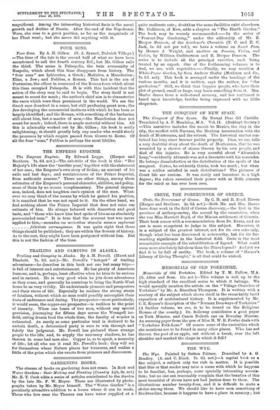FOUR SONS.
Four Sans. By A. H. Gilkes. (G. A. Synnot, Dulwich Village.) The time of the tale is the second half of what we have been accustomed to call the fourth century B.C., but Mr. Gilkes calls the third. The scene is Palaepolis, the twin community of Neapolis, which about this time disappears from history. The "four sons" are Iphicrates, a Greek; Makistos, a Macedonian; Elias, a Jew ; and Publius, a Roman. This last is the son of Postumins, the officer in command of the Roman force which about this time occupied Palaepolis. It is with this incident that the action of the story may be said to begin. The story itself is not meant to count for much ; the author's chief aim is to characterise the races which were then prominent in the world. We see the Greek race decadent in a sense, but still producing great men; the Jew developing the commercial instincts with which he has been so largely identified; and the Roman, with something of the barbarian still about him, but a master of men, the Macedonian does not count for much ; indeed, there is ample material without him. All this is admirably worked out by Mr. Gilkes ; his book is really enlightening; it should greatly help any reader who would study the processes by which empire passed from Greece to Rome. Of all the four "sons," Publius is perhaps the most lifelike.






















































 Previous page
Previous page